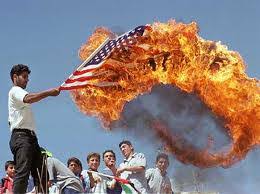LIBYAN MILITIAMEN OPENED fire yesterday on white-flag-waving
protesters demanding their disbandment, killing at least 31 people and
wounding more than 200 in a barrage of heavy machine gun and
rocket-propelled grenade fire.

Libyan Prime Minister Ali Zidan blamed the protesters and the militia alike for the violence, though witnesses said they saw no protesters carrying weapons ahead of the shooting yesterday afternoon.
Armed groups set up checkpoints across the Libyan capital, hoping to stop other militias from entering the city.

Ambulance sirens wailed into the night.
The march in Tripoli by thousands of protesters was the biggest show of public anger at militias in months.
Since the 2011 fall of dictator Moammar Gadhafi, hundreds of militias — many of them on government payroll — have run out of control in Libya, carving out zones of power, defying state authority and launching violent attacks.
The protesters marched from a downtown mosque to a neighbourhood called Gharghour, home to the headquarters of a militia originally from the city of Misrata that has a powerful presence in Tripoli. Many militias have turned villas and residential compounds of former Gadhafi-era officials into camps where they stash weapons.
The demonstrators waved Libyan and white flags and chanted, “We want an army, we want police,” referring to demands that the country’s weak security forces take the place of militias.
When they neared the building, militiamen in civilian clothes and military uniforms came out of the headquarters, opening fire. Protesters ran from gunfire while carrying others covered in blood.
Libyan state television put the death toll at 31, with 235 people wounded.
Witnesses all said the protesters carried no weapons. Al-Taher Basha Agha, commander of Misrata-based militia, told Libya’s private al-Ahrar television station that their rivals used the protesters as a cover to attack.
Asked if he would leave Tripoli, the commander said that his men will leave only “dead bodies.”
Libya’s militias grew out of the informally created local brigades of rebels who battled Gadhafi’s military. Since his fall and death, the government has turned to militias to keep the peace.

But government pay has not put them under state control. The armed groups — some of which include Islamic militants — act on their own agendas. Many of them carry out kidnappings, torture and targeted killings.
The government has put a December deadline on groups to join state security forces or face losing their government paychecks — though it is not clear if the government will cut them off. It has made similar threats in the past.
Libyan Prime Minister Ali Zidan blamed the protesters and the militia alike for the violence, though witnesses said they saw no protesters carrying weapons ahead of the shooting yesterday afternoon.
Armed groups set up checkpoints across the Libyan capital, hoping to stop other militias from entering the city.
Ambulance sirens wailed into the night.
The march in Tripoli by thousands of protesters was the biggest show of public anger at militias in months.
Since the 2011 fall of dictator Moammar Gadhafi, hundreds of militias — many of them on government payroll — have run out of control in Libya, carving out zones of power, defying state authority and launching violent attacks.
The protesters marched from a downtown mosque to a neighbourhood called Gharghour, home to the headquarters of a militia originally from the city of Misrata that has a powerful presence in Tripoli. Many militias have turned villas and residential compounds of former Gadhafi-era officials into camps where they stash weapons.
The demonstrators waved Libyan and white flags and chanted, “We want an army, we want police,” referring to demands that the country’s weak security forces take the place of militias.
When they neared the building, militiamen in civilian clothes and military uniforms came out of the headquarters, opening fire. Protesters ran from gunfire while carrying others covered in blood.
Libyan state television put the death toll at 31, with 235 people wounded.
Witnesses all said the protesters carried no weapons. Al-Taher Basha Agha, commander of Misrata-based militia, told Libya’s private al-Ahrar television station that their rivals used the protesters as a cover to attack.
Asked if he would leave Tripoli, the commander said that his men will leave only “dead bodies.”
Libya’s militias grew out of the informally created local brigades of rebels who battled Gadhafi’s military. Since his fall and death, the government has turned to militias to keep the peace.
But government pay has not put them under state control. The armed groups — some of which include Islamic militants — act on their own agendas. Many of them carry out kidnappings, torture and targeted killings.
The government has put a December deadline on groups to join state security forces or face losing their government paychecks — though it is not clear if the government will cut them off. It has made similar threats in the past.






No comments:
Post a Comment